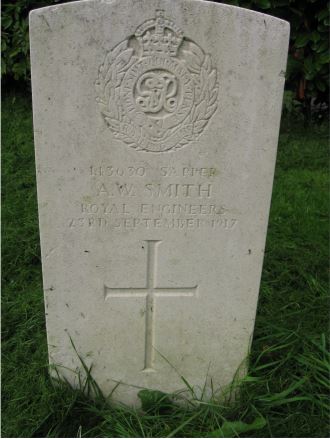121st Field Company, Royal Engineers

Archibald William Smith was born in Gloucester on 29 March 1884. His parents were George Smith (a carpenter/wheelwright) and his wife Harriett (née Parker) and they were believed to have had nine children. At the time of the 1891 Census the family lived at Reservoir Cottage, Tuffley, Gloucester. By the time of the next census (1901) they were living at 9 Waterpools Lane.
In early 1904 Archibald married Emily Rosina Whiley (born 25 June 1882). She appeared to have been pregnant with their first child, Ruby Evelyn, born in March of that year. A further two children followed, George William (1906) and Albert Thomas (1908). At the time of the 1911 Census the family lived at Ashmead Villas, Lower Tuffley, Gloucester and Archibald was working as a carpenter. Two more children followed, Ivor Herbert (1912) and Arthur U (1915). Sadly, Arthur died two years later.
Hardly any documentary evidence of Archibald’s Army service has survived. According to Soldiers Died in the Great War he enlisted in Gloucester and from his Medal Rolls Index Card we know that he first served in the King’s Royal Rifle Corps (with number 14242). In the absence of a Service Record the actual date of enlistment cannot be determined but the relatively low number perhaps indicates this was sometime in 1915 and the men with similar numbers served with the 7th Battalion, which first went to France in May 1915. The date, or reason for his switch to the Royal Engineers (RE) is not known, however, during this research a news item was discovered in the Hartlepool Northern Daily Mail of 11 July 1916, which does indicate that the transfer had taken place before mid-summer 1916.
The news item stated that Archibald William Smith, aged 32, of the Royal Engineers had been sent to gaol for three months at Chester Assizes for bigamy at Stalybridge, (near Manchester). It was said that he had a wife and five children in Gloucester when he married a young woman he met in Buxton. He confessed he was already married a week after the (bigamous) marriage had taken place.
Archibald’s skills as a carpenter would have undoubtedly been useful in the 121st Field Company, RE, to which he had been assigned (and given the number 143630). However, the actual reason for his re-deployment is not known. RE Field Companies undertook a wide range of technical and construction duties on the Western Front, from general maintenance and light road repairs to dugout construction. The 121st Company was assigned to the 36th (Ulster) Division. The CWGC ‘Debt of Honour’ register also refers to service with ‘TC, RE, Newark’, which is probably the Training Centre, Royal Engineers at Coddington Hall, near Newark. Once again, in the absence of a service record it is impossible to track Sapper Smith’s movements from when he joined the RE.
Sapper Archibald William Smith died in the General Hospital at Newcastle-upon-Tyne on 23 September 1917, aged 33. The Register of Soldiers’ Effects held at the National Army Museum states that he died of wounds, however, a recently released Pension Record Card (PRC) states that death was due to sub-acute nephritis (inflammation of the kidney) and terminal bronchial pneumonia, contracted on active service. The PRC explanation is more likely. His widow was granted a pension, with an allowance for their four surviving children.
A notice of Archibald’s death appeared in the Gloucester Journal of 29 September 1917, with his address shown to be 65 Granville Street, in the Linden area of Gloucester. He was buried in Gloucester Old Cemetery, where a standard CWGC headstone marks his grave. He is also commemorated on the Gloucester War Memorial and that placed in St Luke the Less Church.
Researched by Graham Adams 18 January 2020
